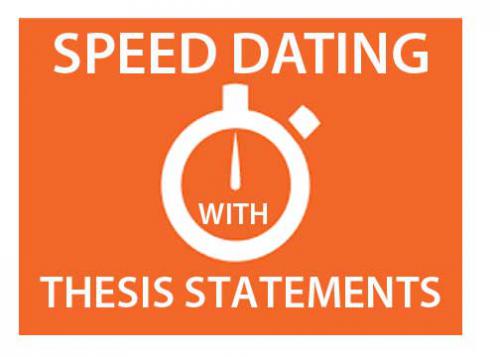You are here
Speed Dating with Thesis Statements
Primary tabs

Amy Tuttle
Meet a room full of thesis statements that want to meet YOU!
Having computers for every student would enable them to save electronic copies of their documents with ease; however, this exercise could easily be adapted for use with pen and paper.
You will need a stopwatch or other timing device.
For this activity, have students bring in a draft of their proposed thesis statement. After a short introduction about what you expect from their thesis statements (which could vary widely, depending on what type of class you’re teaching), provide questions for students to answer about their peers’ claims.
Give students 2 minutes to provide feedback to each thesis statement, as you keep time and facilitate their rotation around the room.
When they’ve made a complete rotation, each student should have a document full of suggestions about how to improve their existing thesis statements.
Instruct students to bring working drafts of their thesis statements to class on the day of the exercise.
Make sure you have a stopwatch or some other timing device handy.
Some instructors may prefer to use an audible signal, like a bell or an alarm, but there's really no other prep involved.
Write your thesis statement in a Word document and save it to your computer as LastNameTHESIS. It may help your readers if you make the thesis statement stand out in some way (larger font, highlighting, bold, etc).
Once everyone is finished writing and saving their thesis statements in the document, you will stand up and move one computer to the right (or clockwise, if computers are in a circular format).
Sit down and read the thesis statement in front of you.
Below the thesis statement, give feedback to the author of the thesis statement about the effectiveness of his or her claim.
Try to respond by rewriting the thesis statement for clarity and specificity. Consider the following templates:
- Tell more about WHY the author's claim is persuasive by adding a "because" statement.
- Foreground something you really like about the thesis statement by expanding on it. Offer additional significance.
- Foreground something that is unclear by making the thesis statement more specific. Replace vague words and phrases with clearer ones.
If you are unable to rewrite the thesis statement, offer narrative feedback, telling the author:
- Why you agree with their thesis statement
- What you like about their thesis statement
- What you wish you knew more about their thesis statement
- What confuses you about their thesis statement
- What you wonder about their thesis statement
- What their thesis statement makes you think of
Hit save after you've left your feedback.
Remember that you will only have two minutes to read and respond to each thesis statement, so think quickly and succinctly. I will signal you when it's time to rotate again.
Also, upon subsequent rotations, remember to return to the author's original thesis statement, leaving all peer feedback intact for the author.
We will repeat this process until you arrive back at your original document, which should be full of ideas for revision!
-

- Log in to post comments

